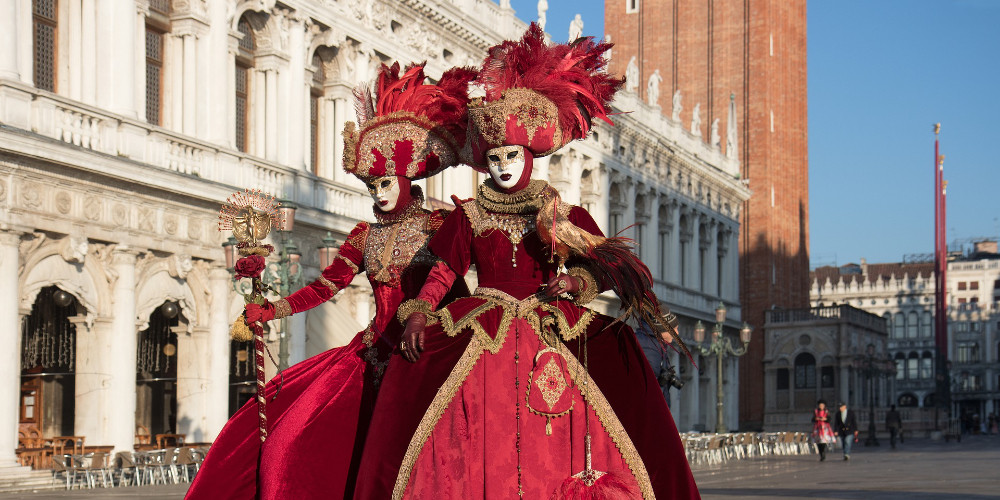
The Carnival of Venice, with its grandeur, originality, historical significance, and colourfulness, causes thousands of tourists to flock to Italy every year.
The history of Venice Carnival dates back to 1094. It is supposed that the carnival was first held this year because of the use of the word “Carnevale” in the document signed by Doge Vitale Faliero. Given the differences between ranks at that time and ensuring the presence of lower-class people at the carnival, they used to wear a mask. It also served anonymity. No matter his or her strata, everyone could have fun together.
However, the first official document on the carnival coincides with 1296 when the Republican Senate declared the Venice Carnival a public holiday before the Great Famine. Since then, the carnival continued for six weeks over the next few hundred years, generally beginning to be celebrated between December 26 and “Ash Wednesday.” In the eighteenth century, the Venetian Carnival had already lived its “golden age.” Recognition in the region and the world has caused visitors to flock to Venice. In 1797, the carnival lost its grandeur with the historical intervention of Napoleon. Only after the two-century “great silence,” as history shows, in 1979, the Carnival of Venice was reorganized with the economic contribution of the Venice Municipality and, of course, to implement the state’s policy of increasing the tourist attraction to the country.
The cultures that originated in the carnival

There are some interesting facts about the Carnival in Venice. The use of masks, as I mentioned earlier, has a long tradition in Venice. Some rituals connect the festival with the ancient Pagan traditions. However, it is possible to meet two ancient cultures and customs in the origin of the history of Carnival of Venice. These are Latin Saturnalia and Greek Dionysian cultures. The carnival, containing both cultures, was able to unite the theatrical masks of Greek culture and the traditions of the Roman Saturnalia in equalization of the strata. What is the purpose of Venice Carnival? In ancient Rome, the differences between the masters and slaves during the festivities in honour of the Saturn deity disappeared for a few days, and there was equalization between the classes. The essential part of Saturnalia was the breaking of all public rules and the dancing of slaves and free citizens under the music. The equality of people at the Venetian Carnival originates from this tradition. What is the purpose of Venice Carnival regarding the usage of masks? Masks are claimed to be part of Greek theatre culture. Besides, people share equal environments without distinction in their class at the places where theatrical performances were shown.

On the other hand, the performances reflected socio-political issues. In the history of Venice Carnival, we can see a synthesis of both cultures, was able to stand the test of time because of such deep roots. The anonymity of the Venetian Carnival due to masks allowed socially disadvantaged groups to mock authority and aristocracy. It also helped to reduce the tension between the classes at least once a year.
Anonymous criminals

Yes, the masks used on the eve of the carnival were supposed to serve anonymity. One of the interesting facts about Carnival of Venice is that some of the criminal cases were concealed under these masks as time went on. Although the primary purpose and origin of the carnival is to suppress tension and discontent, it has had the opposite effect. People’s desire to hide their identity was revealed in the traditional carnival costumes and masks in Venice. Thefts, crime, and rape cases began to rise. As a result, the Venetian government was forced to ban carnival costumes and masks. The first restriction came in 1339 with a decree prohibiting night masking during the Venetian Carnival.
Nevertheless, over time, the situation was getting worse. The number of hooligans who commit immorality by going to churches or monasteries in women’s or religious clothing began to increase. To prevent such movements, it has been forbidden to enter the holy places with the mask during the Venetian Carnival in the fifteenth century. To increase the safety of Venetians, carrying objects that could be criminal tools was also banned.
To enter the casino with masks and carnival costumes during the Venice Carnival was prohibited in the eighteenth century. Until then, the Venetians were allowed to wear masks six months before the carnival. People mostly wearing black velvet masks began to appear in gambling halls in the casinos. In spite of the measures taken, criminal cases were still occurring, and this undermined the idea of freedom and equality, which was at the heart of the Venetian Carnival. Finally, as a result of Napoleon’s occupation of the Republic of Venice and part of Italy in 1797, it was entirely forbidden to walk in the carnival costumes in Venice except for Venetian palaces. However, a few more Italian islands continued to celebrate it peacefully. In 1930, Mussolini stopped the celebration of this ceremony. The carnival was again celebrated with great enthusiasm, but only after a two-hundred-year interval in 1979.
Carnival characters

Today, the Carnival of Venice has become a great festival held in two weeks. Many events, especially attractive masquerade balls, require an invitation and have incredibly high prices. However, many free events like concerts and street performances are open to the public. Of course, you will need at least a mask when going to the Venice Carnival. Although most mask stores sell low-cost masks throughout the year, these prices can increase during carnival time. In the days of the Carnival, Baroque-style costumes, 18th-century Venice military dresses, different styles, colourful and exquisite costumes, and all sorts of fairy tales appear on the streets of Venice. The following shops will be helpful for you to facilitate costume searches for a masquerade ball. You can either shop online or but at these stores while in Venice:
- Mask shop Venice
- Ca’Macana
- Benor Machera Venezia
- Ca’ del Sol Machere
Memorable moments of the carnival

If the masks and costumes are ready, you can join the festival. When is the Carnival of Venice? This year Venice Carnival will be held on February 8-25. During the carnival, there are events all over Venice, especially at St. Mark’s Square. As every year, the carnival begins with the show “The Flight of the Angel,” a ritual dating back to the 1500s, and the yacht competition. The Flight of the Angel (Volo dell’Angelo) is a massive event with about 70,000 people participating every year. The event takes place on the first Sunday of the Carnival as an “angel” flying from the highest tower to the square. The angel who will fly is chosen from among the most beautiful girls of the previous year. The Flight of the Angel (which will take place on February 16 this year) has an ancient history. The Flight of Eagle (Volo dell’Aquila), which is held on the second Sunday of the Carnival (on February 23 this year), is a new beginning tradition that resembles the Flight of the Angel. During the Flight of the Lion (Svolo del Leon), which take place on Tuesday, the last and main day of the carnival (this year it will be on February 25), the flag with lion figure, the symbol of Venice, is being lowered from the tower into the crowd at the square. Angels (women) called Maria to meet it on stage. After this show, the carnival is closed. This event is also symbolic because the lion is a symbol of Venice.
Given that the carnival has a two-week rich program, other alternatives should also be considered. Classical music concerts, such as Vivaldi’s “Four Seasons,” theatre performances and operas (“The Barber of Seville” is dominating) are among the things that tourists want to attend. Of course, it would be much more expedient to make a program in advance. You can find out more about the Carnival diary, information about the balls, and other activities at the link shown below:
Events calendar

Among the events most tourists attend is a ball in honour of Casanova, known for his love adventures. Scenes from Casanova’s adventures and many exciting games are presented to the guests at the ball (to be held on February 22-23 this year). Besides, the prison, where Casanova once was imprisoned, is open for tourists. One of the interesting facts about Carnival in Venice is the existence of the Best Mask Competition. You can also book tickets in advance for the Best Mask Competition from the carnival’s official page. During the carnival, there will be a competition on the big stage set up in the middle of San Marco Square to choose the most successful mask (to be held on February 16 and 20 this year). All participants with costumes (tickets) sit here, and the jury decides the best mask.
There is no need for a time machine to be a part of the history of Venice Carnival and travel to the centuries ago for a few days. All you need for this is to make reservations in advance and contact the professionals who will assist you in this work and offer visa services. Pickvisa.com offers you the professional Italy visa services you are looking for.
Get your visa with one click
Ready to get visa assistance without waste time?



